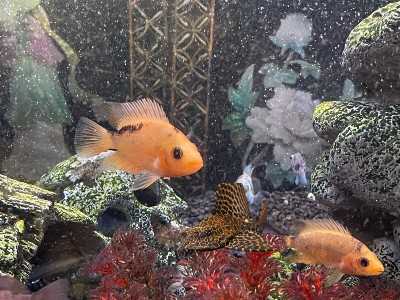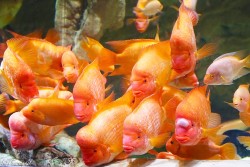Red Devil Cichlid and Pleco: Exploring Compatibility, Tank Dynamics, and Strategies for a Balanced Aquatic Community
 Embarking on the journey of creating a captivating aquarium ensemble involves careful consideration of the inhabitants' personalities, behaviors, and compatibility. In this exploration, we delve into the dynamic world of cohabitating Red Devil Cichlids and Plecos, two charismatic species that, despite their differences, can coexist harmoniously in a well-designed aquarium.
Embarking on the journey of creating a captivating aquarium ensemble involves careful consideration of the inhabitants' personalities, behaviors, and compatibility. In this exploration, we delve into the dynamic world of cohabitating Red Devil Cichlids and Plecos, two charismatic species that, despite their differences, can coexist harmoniously in a well-designed aquarium.From understanding the distinctive traits of these aquatic personalities to navigating the intricacies of tank dynamics, this article aims to guide aquarists through the process of fostering a balanced aquatic community. Join us as we unravel the complexities and unveil the beauty of integrating the vibrant Red Devil Cichlid with the versatile Pleco, offering insights, strategies, and real-world experiences to enhance your underwater world.
Introduction
- Red Devil Cichlid (Amphilophus labiatus) and Pleco (Hypostomus plecostomus) are renowned in the aquarium hobby, each bringing unique characteristics and charm to underwater landscapes. This article delves into the exciting realm of keeping these two distinct species together, exploring the potential challenges and joys of Red Devil Cichlid and Pleco cohabitation.
Understanding Red Devil Cichlid and Pleco
- Red Devil Cichlid: Known for its striking colors, aggressive behavior, and distinctive hump on its head, the Red Devil Cichlid is a charismatic centerpiece in many aquariums. Understanding their territorial instincts and social behaviors is crucial for successful integration.
- Pleco: Recognized for its algae-eating prowess and diverse species, Plecos add a touch of diversity. Learning about their nocturnal habits, compatibility with other fish, and preferences for hiding spots provides essential insights.
Compatibility Factors
- Navigating the compatibility terrain involves acknowledging the territorial nature of Red Devil Cichlids and the generally peaceful demeanor of Plecos. Balancing these differences requires strategic planning and understanding of each species' behaviors.
Tank Dynamics
- Tank Size and Layout: Red Devil Cichlids and Plecos both benefit from spacious environments. An appropriately sized tank with distinct territories, caves, and hiding places creates a harmonious habitat.
- Decor and Distinct Territories: Designing the tank with consideration for each species' need for territory helps minimize potential conflicts. Utilizing rocks, driftwood, and plants strategically establishes zones of ownership.
Strategies for a Balanced Aquatic Community
- Feeding Considerations: Red Devil Cichlids are omnivores with a penchant for live or frozen foods, while Plecos are herbivores. Crafting a diet that accommodates both, possibly through sinking pellets, ensures nutritional needs are met.
- Water Conditions: Maintaining stable water parameters, including temperature and pH, is essential. A clean and well-filtered environment caters to the preferences of both species.
Case Studies and Success Stories
- Real-world Examples: Sharing anecdotes of aquarists successfully keeping Red Devil Cichlids and Plecos together, highlighting their experiences, tank setups, and lessons learned.
Troubleshooting Challenges
- Aggression Management: Addressing potential aggression issues with methods such as rearranging the tank, providing additional hiding spots, or temporary separation.
- Health Concerns: Recognizing signs of stress or illness and promptly addressing them through quarantine or treatment protocols.
Beyond Compatibility: The Aesthetic Appeal
- Visual Harmony: Appreciating the contrasting colors and behaviors of Red Devil Cichlids and Plecos creates a visually dynamic and engaging aquarium. Enhancing the aesthetic appeal with thoughtful decor choices elevates the overall underwater experience.
Conclusion
- Key Takeaways: Summarizing the crucial considerations for successfully maintaining Red Devil Cichlids and Plecos together, encouraging aquarists to embrace the challenges and joys of creating a diverse and thriving aquatic community.
